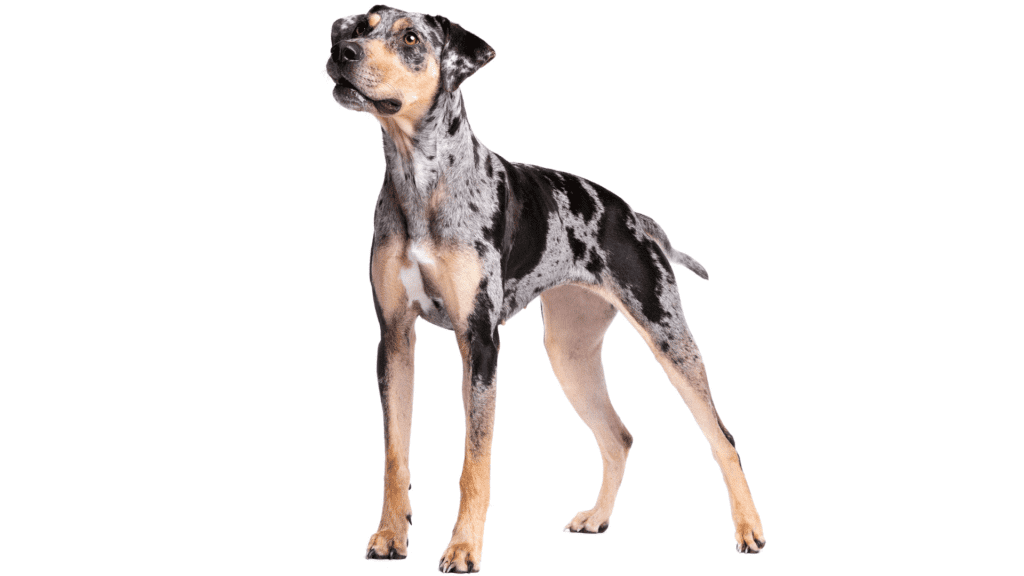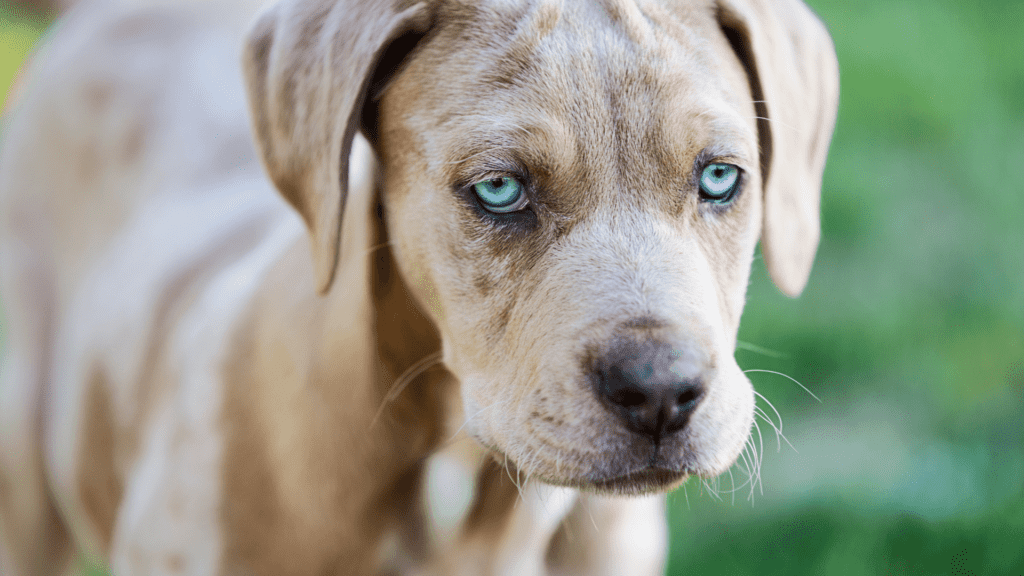The rare colors of the Catahoula breed are solid red and single-merle yellow.
The official state dog of Louisiana is peculiar and diverse in its distinguished appearance.
For instance, some dogs have a combination of piebald coats in shades of brown, gray, silver, and even crimson.
Others have tiger-stripe-like brindle prints, while others only have a single color, such as white, black, blue, or brown.
What makes them even more distinct and adorable is their varied eye colors. Some have remarkable glass eyes that come in pale blue and white.
Others have luminous green, blue, brown, and amber.
Are Rare Catahoula Dogs Recognized or Classified?
This may come as a surprise to you, but the whole Catahoula breed didn’t receive full recognition yet. That’s partly because the breed is still relatively new and rare.
That explains why the breed has a Foundation Stock label on the American Kennel Club’s website rather than the ordinary group label.
This means that there are no clear standards for the breed, whether the dogs come in rare or ordinary colors.
If you manage to get your hands on a rare Catahoula with a distinct coat, it may be challenging to register it.
Do Rare Catahoula Colors Come With Health Risks?
The health risks of rare Catahoula colors are still not fully explored. However, there’s one thing to take into consideration: dogs with blue eyes are more prone to serious eye conditions.
Catahoulas are among the few breeds that can have naturally blue eyes, namely with the merle coat pattern.
So, if your rare pup has a pair of striking blue eyes, it’s better to consider the costs and the possible risks of taking care of it.
Different Color Terms of Catahoula Dogs Explained
The Catahoula breed is called the ‘Leopard dog' because of its multicolor and spotted coat.
Here’s an overview of the different terms associated with the breed’s coat colors.
• Patchwork

The term patchwork often refers to the several different color patches over the canine’s coat.
These patches are usually huge and scattered, giving a blemish and a more ripped look than a typical leopard.
The backdrop color for these patches is often white or an identical light color. This variation is specifically present in the merle gene.
• Leopard
This term refers to the merle color marks.
Due to the presence of the merle gene, some hairs become totally pigment-free.
Even with thick color spread everywhere on the coat, the dominating effect on the appearance is the dilution of color.
Merle marks are not visible in areas of the body with pheomelanin (tan color) and white trim. The colors black, blue, and liver are the only pigments that show the merle pattern.
• Red Leopard
The term refers to the red merle coloration. Red leopards are merle-patterned, genetically liver-colored canines.
Catahoulas with this gene have colors of reddish-brown or tan with shadier red or brown marks scattered throughout the coat.
• Blue Leopard
A term that refers to the color marks known as blue merle. The Blue leopard coloration is actually a genetically black Catahoula variety with a merle pattern.
The color is a grayish coat with a few scattered patches of black.
Most of the blue leopards' colors are light gray or predominantly black. It’s sometimes called “gray leopard” and “black leopard.”
• Silver Leopard
Catahoulas usually have colorations of blue merle or red merle patterns. When a Catahoula has a dilute-blue merle pattern, it becomes a Silver Leopard.
• Double Merle
Double merles typically have a lot of white in their coats.
It is a Catahoula variety with the merle gene in two copies, inheriting one from each parent.
It is susceptible to deafness because of the deficiency of pigmentation. In double merles, eye abnormalities also develop more frequently.
Breeding two merles together would increase the likelihood that the progeny will be double merles and could have defects.
• Ghost or Phantom Merle

Ghost or Phantom Merle refers to canines that have solid-colored phenotypes but are genetically merle.
Though there are different uses of the terms, the latest findings in genetic research provide more specific data about phantom merles.
The merle pattern displays outside marks such as tiny leopard spots and glass eyes (including partial glass eyes). Phantom merles, as the name suggests, don't have these signs.
Nonetheless, many cynophiles will refer to the merle dogs as “ghosts” or “phantoms” because they appear mainly solid.
Upon closer examination, however, there are tiny and unnoticeable leopard spots and glass eyes.
Some Catahoulas look like leopards when they are puppies. But when they grow, their hues darken and become practically solid-colored.
These are not genuine ghost merles but are merely dark leopards.
Phantom merle is generally a variation of the merle gene that is unnoticeable from solid.
• Excessive White
The term is an allusion to double merles. Though the usage of the term is commonly in a subjective “slang-ish” way.
The inordinate white coloration is often due to the piebald spotting marks.
The excessive white color may be a sign of a higher chance of hearing impairment in Catahoula dogs.
• Trim White
Quite opposite from the excessive white coloration, the term refers to the limited white markings that appear in the trim areas of the canine’s body.
These markings appear in the chest, belly, ring neck, legs, blaze face, and tail tip.
• Brindle
The term refers to the dark stripes that appear on the color patterns that overlap the tan backdrop.
• Glass Eyes

Pertinent to the colors blue or blue-white eyes, ‘double glass eyes' is the name for Catahoulas with two glass eyes.
Occasionally, one glass eye has parts of different colors from the other glass eye.
When the same eye has both shadier hues and glass parts, we call it ‘marbled glass' or ‘crackled glass.'
Usually, only leopard merle has glass/fragmentary glass eyes.
But leopards can sometimes also have glass eyes, especially in piebalds, though without the aid of the merle gene.

Calvin is the co-founder and one of the main contributors to dogtemperament.com. He has been an avid dog lover all his life. He enjoys researching and sharing great ideas on how you can avoid common pitfalls of dog ownership and build the most loving and enjoyable relationship with your dog.